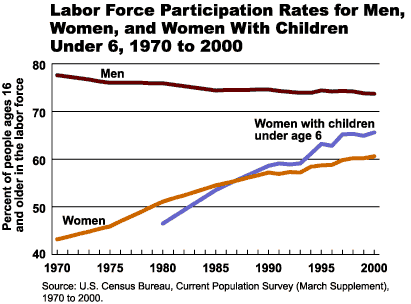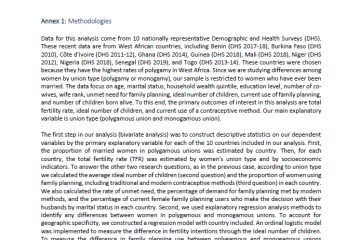
Record Number of Women in the U.S. Labor Force
(February 2001) Over the past 30 years, there have been dramatic changes in women’s participation in the U.S. labor force. In 1970, about 43 percent of women ages 16 and older were in the labor force. By 2000, 61 percent of adult women were in the labor force. Over the same period, men’s labor force participation rates declined from 78 percent to 74 percent. These trends are part of broader changes in the labor force that have occurred since the middle of the 20th century. The rapid increase in women’s labor force participation, combined with the simultaneous decline in men’s participation, has closed much of the gender gap in the labor force. In 2000, about 47 percent of people in the labor force were women. If current trends continue, women will soon make up the majority of the U.S. work force.
The decline in men’s labor force participation can be explained by increasing incomes of people over age 50, made possible through the expansion of benefits provided by both Social Security and private pensions. Social Security provides full benefits for retirees at age 65 (the retirement age will increase to 67 in coming years) and partial benefits beginning at age 62.
The increase in women’s labor force participation is not as easily explained. Some cite expanding job opportunities for women, while others argue that women were compelled to enter the work force because of men’s low earnings.
In recent years, much of the increase in women’s labor force participation can be attributed to the rising participation rates of women with young children. In 1980, less than half of women with children under 6 were in the labor force, compared with two-thirds of women with young children today. Although most women with young children are in the labor force, only about half of these working mothers are employed full-time, year-round.

Citations
PRB analysis of data from the U.S. Census Bureau, Current Population Survey (March Supplement), 1970 to 2000; Howard N. Fullerton, Jr., “Labor Force Participation: 75 Years of Change, 1950–98 and 1998–2025,” Monthly Labor Review (December 1999): 3–12; Howard V. Hayghe, “Developments in Women’s Labor Force Participation,” Monthly Labor Review (September, 1997): 41–46; and Phillip Cohen and Suzanne Bianchi, “Marriage, Children, and Women’s Employment: What Do We Know?” Monthly Labor Review (December 1999): 22–31.





